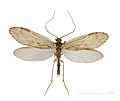| Aparaglossata | |
|---|---|
 | |
| All aparaglossata extant orders: row 1: Raphidioptera , Trichoptera | |
| Scientific classification | |
| Domain: | Eukaryota |
| Kingdom: | Animalia |
| Phylum: | Arthropoda |
| Class: | Insecta |
| Clade: | Holometabola |
| Clade: | Aparaglossata Peters et al. 2014 |
| Clades | |
Aparaglossata is a clade of insects comprising all modern holometabolous insects except for Hymenoptera. [1] The clade is named for one of its most recognizable synapomorphies (shared distinguishing feature); the absence of paraglossae. The clade is also characterized by a modification of the ovipositor and a reduction in number of Malpighian tubules.
The larval groundplan of Aparaglossata was prognathous, had well-developed stemmata, and an H-shaped tentorium.

